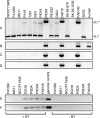Opportunity and means: horizontal gene transfer from the human host to a bacterial pathogen
- PMID: 21325040
- PMCID: PMC3042738
- DOI: 10.1128/mBio.00005-11
Opportunity and means: horizontal gene transfer from the human host to a bacterial pathogen
Abstract
The acquisition and incorporation of genetic material between nonmating species, or horizontal gene transfer (HGT), has been frequently described for phylogenetically related organisms, but far less evidence exists for HGT between highly divergent organisms. Here we report the identification and characterization of a horizontally transferred fragment of the human long interspersed nuclear element L1 to the genome of the strictly human pathogen Neisseria gonorrhoeae. A 685-bp sequence exhibiting 98 to 100% identity to copies of the human L1 element was identified adjacent to the irg4 gene in some N. gonorrhoeae genomes. The L1 fragment was observed in ~11% of the N. gonorrhoeae population sampled but was not detected in Neisseria meningitidis or commensal Neisseria isolates. In addition, N. gonorrhoeae transcripts containing the L1 sequence were detected by reverse transcription-PCR, indicating that an L1-derived gene product may be produced. The high degree of identity between human and gonococcal L1 sequences, together with the absence of L1 sequences from related Neisseria species, indicates that this HGT event occurred relatively recently in evolutionary history. The identification of L1 sequences in N. gonorrhoeae demonstrates that HGT can occur between a mammalian host and a resident bacterium, which has important implications for the coevolution of both humans and their associated microorganisms.
Copyright © 2011 Anderson and Seifert.
Figures


Comment in
-
Taking the gonococcus-human relationship to a whole new level: implications for the coevolution of microbes and humans.mBio. 2011 Apr 26;2(3):e00067-11. doi: 10.1128/mBio.00067-11. Print 2011. mBio. 2011. PMID: 21521723 Free PMC article.
References
-
- McDaniel T. K., Kaper J. B. 1997. A cloned pathogenicity island from enteropathogenic Escherichia coli confers the attaching and effacing phenotype on E. coli K-12. Mol. Microbiol. 23:399–407 - PubMed
-
- Lawrence J. G., Ochman H. 1997. Amelioration of bacterial genomes: rates of change and exchange. J. Mol. Evol. 44:383–397 - PubMed
-
- Goldman B. S., Kranz R. G. 1998. Evolution and horizontal transfer of an entire biosynthetic pathway for cytochrome c biogenesis: Helicobacter, Deinococcus, Archae and more. Mol. Microbiol. 27:871–873 - PubMed
-
- Feil E., Zhou J., Smith J. Maynard, Spratt B. G. 1996. A comparison of the nucleotide sequences of the adk and recA genes of pathogenic and commensal Neisseria species: evidence for extensive interspecies recombination within adk. J. Mol. Evol. 43:631–640 - PubMed
Publication types
MeSH terms
Grants and funding
LinkOut - more resources
Full Text Sources
Other Literature Sources
Medical
Molecular Biology Databases

